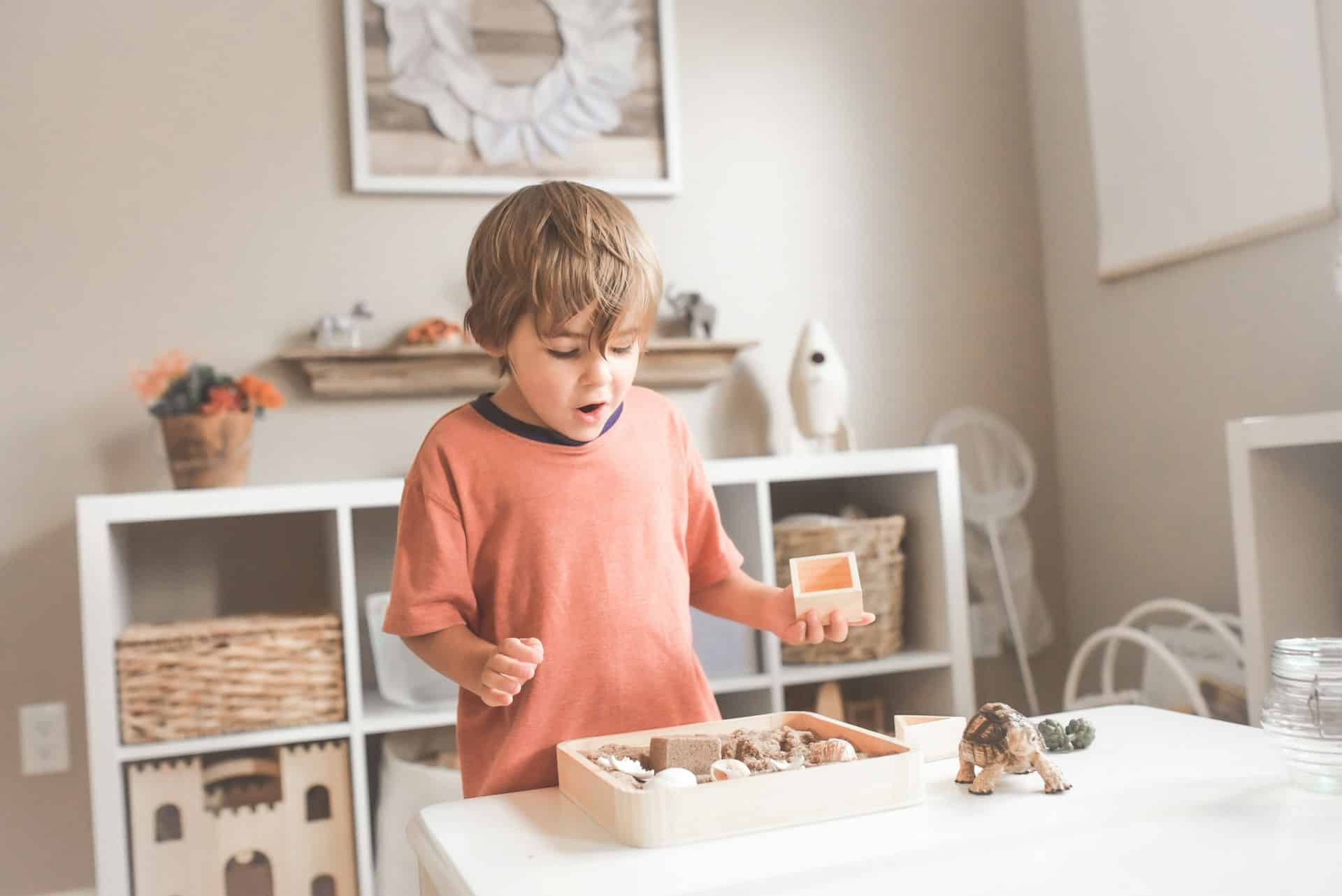Seeing clearly the whole, the parts that make a whole; seeing specific parts without being distracted by other parts, being able to complete a part in the mind’s eye, recalling what you see, being able to see the visual difference between things are all key perceptual skills that influence our interactions with the world and contribute to our learning processes.
The different visual perceptual skills with activities that children engage with using that perception are described as follows, including activities to help develop the specific perceptual skill:
Visual Closure is the ability to visualize a complete whole when given incomplete information or a partial picture. This skill helps children read and comprehend quickly. This skill can also help children recognize inferences and predict outcomes. Children with poor visual closure may have difficulty completing a thought or making an accurate judgement from partial information . They may also confuse similar objects or words, especially words with close beginning or endings.
It is a foundation skill for fluency and speed in reading and spelling.
The activities help a child to create a recognizable visual image.
1. Jigsaws.
2. Dot to dots.
3. Coloring in.
4. Word searches.
5. Writing or drawing in sand or foam.
6. Incomplete sentences. Fill in the missing letters or words.
7. Matching complete and incomplete shapes.
8. Construction games.
9. Scrabble.
10. Stencils.
11. Model making
12. Building 3D models. E.g. K’nex.
13. Partially covering a picture and asking the child to identify the whole.
Visual Discrimination is the ability to determine characteristics and distinctive features among similar objects or forms. In reading, this skill helps children distinguish between similarly spelled words, such as was/saw, then/when, on/one, or run/ran.
1. shape match– matching shapes to fit the correct opening
2. Odd one out 2 – pictorial (apple, orange, banana, cup)
3. Matching sequences – color, shape and size
4. Spot the difference – searching for visual similarities and differences between two pictures
5. Match the detail – matching a picture of a small detail to the larger whole picture
6. Shapewords – matching high frequency words to a shape outline
7. Letter Change (cat, cot, cut)
8. Odd word out – both oral and written (eg. hand, land, lend, stand).
9. Wordsearches – using high frequency words or rhyming words.
10. Draw letters/words on his/her back then have child write on paper
11. Letter search in a magazine then make a collage
12. Recognizing items through touch only
Visual Figure Ground is the ability to perceive and locate a form or object within a busy field without getting confused by the background or surrounding images. This skill keeps children from getting lost in details. Children with poor figure-ground become easily confused with too much print on the page, affecting their concentration and attention. They may also have difficulty scanning text to locate specific information.
Activities to help :
Games
1. Doble
2. Jigsaws
3. Painting by numbers
4. Board games e.g. Snakes and ladders, Monopoly
5. Pick up Sticks
Pencil and Paper Activities
1. I Spy
2. Find the Odd one out
3. Circle the same word in a text
4. Find certain punctuation
5. Find words beginning with “t”, ending with “ing” or containing “ou”.
Overlapping Objects
Prepare a worksheet containing overlapping objects. Ask your child to outline specific objects. E.g. the triangle in red.
Sorting Activities
This helps children to concentrate on specific stimuli. It involves correct identification of size, shape, color etc.
1. Mix 2 – 3 types of items and ask children to sort them e.g. pasta / buttons
2. Pick out one type of object from a box containing a mixture of items
3. At first the objects should differ greatly and progress to them to very similar E.g. Sort beads / blocks / reels of different size and color. Sort different textures. Find a square button in a box of round ones or a blue marble in a box of green ones
4. Computer games requiring sorting or matching.
Circle the Word
Make a worksheet of several rows of designs. Each row contains a word/letter for your child to circle.
E.g.
ccccccactccocccccc
uuupuuuuuuuuuuuu
ttttttttttttttttttttttfeltttttt
Color the Design
Make a design on paper repeating it many times. Specify a part of it to be a color e.g. color the blocks under the lines.
Visual Form Constancy is the ability to mentally manipulate forms and visualize the resulting outcomes. This skill helps children distinguish differences in size, shape, and orientation. Children with poor form-constancy may frequently reverse letters and numbers. The ability to recognize the fact that a shape remains the same despite changes in size, direction, orientation and distance.
A child with visual form constancy problems may have difficulty with:
1. Making Lego / K’nex from the instructions
2. Recognizing that a picture is the same as a real object
3. Judging size, height, width, distance
4. Categorizing and classifying objects, shapes and materials
5. Recognizing everyday objects when put in unusual positions or are a different size
6. Mislaying items and being unable to find them, as they cannot instantly recognize them
7. Recognizing / reading the same word in different fonts, typefaces etc
8. Transferring from printed to cursive handwriting
9. Organization of self and objects
10. Daily tasks E.G. dressing, crossing the road or pouring a drink.
Activities to help
1. Touch, feel and talk about 3D objects when their size or orientation may alter E.g. a saucepan
2. Copy 3D patterns and shapes. E.g. brick designs or origami
3. Color in 3D drawing and models
4. Match 3D objects for size, shape, volume, density from boards varying the presentation
5. Model making
6. Compare and contrast the size and shape of objects
7. Build up 3D geometric shapes
8. Make 3D models from 2D diagrams E.g. Lego, K’nex,
9. Demonstrate how horizontally presented material looks when it is vertically presented
10. Use visual cue cards to identify objects seen from different angles such as above, underneath, behind etc
11. Select a shape from a sorting box and place it at a distance in the room. The child must find the same shape from the box
12 From a box of mixed sized balls, roll one across the floor. The child has to select the same sized ball from the box
13. Write the same word in many styles, colors and prints together with other words. The child should underline the same word in its different forms
14. Visual discrimination cards
15. Outline jigsaws enable a child to see how individual parts fit together to make a whole
16. Fill in outlines with geometric shapes. Progress from matching a shape to its outline to a stage where several shapes are needed to fill an outline
Visual Memory is the ability to immediately recall the characteristics of a given object or form. This skill helps children remember what they read and see by adequately processing information through their short-term memory and into the long-term memory. Children with poor visual memory may struggle with comprehension. They may softly whisper to themselves, as they read in order to help compensate auditorily. They may have difficulty remembering what a word looks like or fail to recognize the same word on another page. They may also take longer copying assignments because they must frequently review the text.
Visual Sequential Memory : the ability to remember forms or characters in correct order. This skill is particularly important in spelling. Letter omissions, additions, or transpositions within words are common for children who struggle with this skill. They may whisper or talk aloud as they write. Recognizing and remembering patterns may also be a problem.
Pupils who have difficulties in this area may:
• have immature drawing skills (drawings lack detail)
• have problems with learning sight vocabulary
• have difficulty with letter and number orientation
• find reading music difficult
• be unable to recall patterns, shapes and designs
• have spelling difficulties
• enjoy using multisensory strategies when learning
• use audio to aid recall of information
• have strengths in logic, verbal and non-verbal reasoning skills
• have kinesthetic strengths (learn better when actively involved in a lesson through movement and touch).
Activities to develop visual memory skills
1. Recall object or picture features – let the child look at an object and talk about its features. Then take the object/picture away and ask them to recall some of its features/details.
2. Complete the shape or picture – show the child a shape or picture and then give them an incomplete drawing of the same shape/picture. Ask the child to complete the shape/picture from memory.
3. Present a picture and have child draw it then remove both pictures and have child draw it from memory.
4. What identify what is missing from one of the pictures.
5. Place everyday objects on a table. Show them to the child for about a minute, then cover them and see how many each can recall. This can also be played by taking one object away and asking the child to identify the object that is missing.
6. Recall and sequence – a series of three to four colored shapes/pictures.
7. What happens next? – complete pictorical action sequences related to everyday situations.
8. Recall and sequence – a series of three to four words in a sentence.
9. Recall and sequence – the alphabet, numbers or words
10. Visual memory spelling games – using the look, cover, remember, write, check strategy with simple high frequency words.
Visual Spatial Relations : Visual Spatial perception provides us with information about our environment. The way a child perceives space and their position or orientation within that space can affect their gross motor skills and classroom performance. It is the ability to distinguish differences among similar objects or forms. This skill helps children in understanding relationships and recognizing underlying concepts. This area is closely related to the problem solving and conceptual skills required for higher level science and math.
Visual Spatial Orientation : helps us with letter reversals. The most common cause of reversals in older children is a lack of visual spatial development–consistently knowing left from right, either in relationship to their own bodies or in the world around them. Children with poor visual processing have not developed adequate skills in visual perception and spatial orientation, such as laterality and directionality.
Is the ability to understand and interpret spatial relationships:
a. Between oneself and other people. E.g. Stand behind Mommy
b. Between oneself and other objects. E.g. put the chair beside Daddy
c. Objects in relation to other objects. E.g. put the brick in the box.
A child with visual spatial problems may have difficulty with:
1. Interpreting instructions. E.g. write your name at the top of the page
2. Dressing. Putting garments on up side down or being unable to turn them the right way round
3. Correctly positioning equipment, such as utensils at meal times
4. Moving themselves in space. In PE games or when doing gymnastics or obstacle courses
5. Tracking mazes
6. Copying patterns or Lego models etc
7. Producing 3D drawings E.g. Houses, boxes or cubes
8. Setting out work on a page, particularly mathematical problems or diagrams
9. Labeling diagrams.
Activities to help
Activities for yourself and one other person or a group
1. Simon Says
2. Leapfrog
3. Crawl under someone’s legs
4. Stand beside the tallest person
5. Cat and mouse games
6. Arrange people to make shapes
7. Obstacle courses
8. Hopscotch
9. Games with hoops, beanbags and boxes.
10. Setting a table
11. Board games e.g. Othello, chess etc
12 Craft activities e.g. collage, origami
13. Construction games e.g. Lego, building a railway track or fort.
Copying Activities
Activities requiring copying 3D to 3D
1. Construction toys e.g. Lego
2. Multi link
3. Peg patterns
4. Patterns with objects using different shapes, sizes and colors.
Activities requiring copying 2D to 3D
In these the child makes the model from copying a card, picture or photograph.
1. Block or peg patterns
2. Model making from pictorial instructions e.g. Lego, K’nex
3. Following a recipe when cooking
4. Origami, copying diagrams in a book.
Activities requiring copying 2D to 2D
1. Copying a picture
2. Copying from the whiteboard
3. Constructing a drawing.
WEBSITES
The following websites also offer activities to practice and develop specific perceptual abilities:
https://eyecanlearn.com/perception/
Also Engaging Eyes by Dyslexia Gold supports visual tracking and helps strengthen eye muscles specifically for reading:






